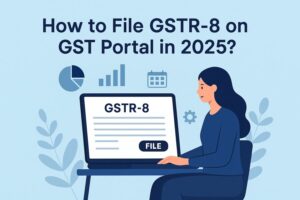Export Bond for GST & Letter of Undertaking
- 19 Aug 24
- 16 mins

Export Bond for GST & Letter of Undertaking
- Export Bond for GST
- Bank Guarantee for Export Bond
- Background to Exports and GST
- Brief on Refund of IGST Paid on Exports
- Steps for claiming refund of IGST paid on Exports
- Import Export Code
- Letter of Undertaking (LUT) for Exports under GST
- How to File Letter of Undertaking (LUT) and Bonds for Exports
- Format of LUT and Bonds in RFD-11
Key Takeaway
- Exporters can use an Export Bond and Bank Guarantee to defer IGST payment on exported goods, ensuring compliance with GST laws while preserving cash flow.
- Under GST, exports are treated as zero-rated supplies, allowing businesses to export goods and services without the burden of GST, enhancing international competitiveness.
- Exporters are eligible to claim refunds for the IGST paid on exported goods, which is crucial for maintaining liquidity and ensuring the cost-effectiveness of Indian products globally.
- A Letter of Undertaking (LUT) enables eligible exporters to ship goods without paying IGST or providing a bond and bank guarantee, simplifying the export process.
- The Import Export Code (IEC) is essential for any business involved in international trade, facilitating seamless customs clearance and compliance with export regulations.
Export Bond for GST
An Export Bond for GST is crucial for exporters who choose to ship goods internationally without paying the Integrated Goods and Services Tax (IGST) at the time of export. This financial instrument ensures compliance with GST laws over the course of the export activities. By submitting an export bond, exporters can effectively defer the tax payment until the completion of export formalities. It acts as a security mechanism for the government, ensuring that all tax obligations will be fulfilled as stipulated.
The bond covers the amount of GST payable on the exported goods. It is typically valid for a period that covers the estimated time of export completion, usually a year, making it suitable for regular exporters who frequently ship goods overseas.
Bank Guarantee for Export Bond

A Bank Guarantee for an Export Bond plays a pivotal role in the realm of exporting under GST. When an exporter decides to submit an export bond, they may also need to provide a bank guarantee, depending on the assessment of their risk and compliance history by the tax authorities.
This guarantee is provided by a bank, which assures the government that the duties and taxes due on the exports will be covered by the bank if the exporter fails to fulfill their tax obligations. The required amount of the bank guarantee can vary. It is often set at a percentage of the bond amount, which typically ranges from 5% to 15%. This percentage is determined based on the credibility and compliance track record of the exporter.
The bank guarantee serves as an additional layer of security for the government, safeguarding the interests of the revenue department and ensuring that the tax liabilities on exported goods are secured even if the exporter defaults. This arrangement allows exporters to maintain their working capital flow without the immediate financial burden of tax payments, facilitating smoother business operations and international trade.
Background to Exports and GST
The introduction of the Goods and Services Tax (GST) in India marked a significant reform in the taxation landscape, particularly impacting the export sector. Before GST, the export sector contended with a complex array of taxes, including Excise Duty, Service Tax, and Value Added Tax (VAT), which often led to a cascading effect of taxes. GST consolidated these multiple taxes into a single tax framework, aiming to simplify the process and make Indian goods and services globally competitive.
Under GST, exports are treated as zero-rated supplies, meaning exporters can ship goods and services without GST charges, thereby avoiding an increase in costs that would typically be passed on to foreign buyers. This shift not only simplified the tax structure but also aimed to boost the export economy by making Indian exports more price-competitive on the global stage.
Brief on Refund of IGST Paid on Exports
One of the critical features of GST for exporters is the provision to claim refunds for the Integrated Goods and Services Tax (IGST) paid on goods and services exported from India. This refund mechanism is vital as it ensures that exports are not burdened by domestic taxes, maintaining the marketability of Indian goods in international markets.
When goods are exported under GST, the exporter can pay IGST and then claim it back as a refund after the goods are shipped. This process helps in maintaining the liquidity for exporters by returning the taxes paid once the export procedure is completed. The refund of IGST not only supports the exporter's cash flow but also reinforces the principle that taxes should not export, thereby reducing the cost of Indian products in the international market.

To claim the refund, exporters must ensure that their shipping bills are aligned with their GST invoices and that all required documentation is accurately filed. The government has also streamlined the refund process with automated systems to expedite the flow of funds back to the exporters, reducing the working capital pressures and helping maintain competitive pricing in global markets.
💡If you want to pay your GST with Credit Card, then download Pice Business Payment App. Pice is the one stop app for all paying all your business expenses.
Steps for claiming refund of IGST paid on Exports
Claiming a refund of the Integrated Goods and Services Tax (IGST) paid on exports is a critical process for exporters to recover the taxes paid, thereby aiding in managing their cash flow efficiently. Here are the steps to claim a refund of IGST paid on exports:
1. Export Goods or Services Under GST Compliance
Ensure that all exported goods or services comply with GST regulations. This includes having a proper GST registration and an active GSTIN (Goods and Services Tax Identification Number).
2. Prepare and File Shipping Bills
When exporting goods, it's essential to prepare and file shipping bills or export declarations which serve as key documents for customs clearance. These documents should be aligned with the GST invoices, detailing the IGST paid on the exported goods.
3. Furnish Export Details in GSTR-1
File the monthly or quarterly GST return form GSTR-1. In this form, provide comprehensive details of the exports made, including the shipping bill number, date of export, invoice details, and the amount of IGST paid. This information should be accurate to ensure smooth processing of the refund.
4. Ensure Auto-Population of Data in GSTR-2A
The details filed in GSTR-1 get auto-populated in GSTR-2A. The exporter should verify that all export and IGST payment details are correctly reflected in GSTR-2A, which will facilitate the refund process.
5. File GSTR-3B with Correct Refund Claims
File GSTR-3B accurately, ensuring that the export turnover and the IGST paid (which you are claiming a refund for) are correctly declared. Proper filing of GSTR-3B is crucial as it is used for the provisional acceptance of your refund claim.
6. Refund Application through GST Portal
After filing the returns, apply for the IGST refund directly on the GST portal. The application should be accompanied by all necessary documents, including copies of invoices, shipping bills, and proof of IGST payment. Ensure that all documents are uploaded correctly to avoid delays.
7. Track Refund Status
After submitting the refund application, regularly track the status of the refund through the GST portal. The system is designed to process refunds within a stipulated time frame, assuming all documentation and filings are in order.
8. Rectify Errors if Any
If the refund application is held up due to discrepancies or errors, the GST portal will notify the exporter. It's important to address these issues promptly by providing the necessary information or documentation required to process the refund.
Import Export Code

The Import Export Code (IEC) is a crucial registration for businesses engaged in importing and exporting goods and services from and to India. It is a unique 10-digit code issued by the Directorate General of Foreign Trade (DGFT), Ministry of Commerce and Industries, Government of India. Here's a brief overview of the IEC and its importance:
Importance of Import Export Code
Mandatory Requirement: The IEC is a mandatory requirement for all businesses planning to engage in international trade. Without this code, a business cannot legally import or export goods and services.
Facilitates Global Trade: Possessing an IEC helps businesses clear customs easily and avails several benefits from the DGFT, Customs, and Export Promotion Council on their imports/exports.
No Expiry: Once issued, the IEC does not require any renewal and is valid for the lifetime of the entity, eliminating any compliance related to renewals.
Bank Transactions: An IEC is required by banks to process foreign bank transactions related to imports and exports.
Applying for an Import Export Code
Step 1: Preparation: Gather all necessary documents, including PAN card, proof of address of the business, and a cancelled cheque from the current business bank account.
Step 2: Filing Application: The application for IEC must be filed online on the DGFT website. The form ANF 2A needs to be filled out and submitted along with the required documents and payment of the application fee.
Step 3: Processing and Verification: Once submitted, the application is processed and verified by the DGFT. Any discrepancies or queries are raised by the authority and need to be resolved by the applicant promptly.
Step 4: Issuance: Upon successful verification, the DGFT issues the IEC to the applicant. This code is sent via email and can also be downloaded from the DGFT portal.
Step 5: Updating Details: If there are any changes to the information provided at the time of IEC registration, such as address or company name, the IEC details must be updated by submitting the necessary documents on the DGFT portal.
Having an IEC is essential for any business looking to expand into global markets, as it simplifies many of the legal and procedural aspects of international trade.
Letter of Undertaking (LUT) for Exports under GST
A Letter of Undertaking (LUT) is an important document under the GST framework that allows exporters to ship goods or provide services to foreign countries without having to pay the Integrated Goods and Services Tax (IGST). Using an LUT, exporters can forego the bond and bank guarantee that are usually required for exporting goods under GST. This provision is particularly beneficial as it helps improve the liquidity of exporters by exempting them from fronting significant tax payments.
Eligibility to File LUT
Exporters who wish to use an LUT must satisfy certain conditions:
- They must not have been prosecuted for any tax evasion exceeding ₹250 lakhs under the CGST Act, IGST Act, any of the existing laws, or the Customs Act.
- They should have a consistent compliance record, including timely filing of returns for the last two fiscal years.
Benefits of Using LUT
- It allows the export without payment of IGST.
- Speeds up the process of exporting goods by reducing paperwork and financial burden.
- Enhances the competitiveness of exporters in the international market.
GST Letter of Undertaking Format
The format for a Letter of Undertaking under GST is standardized in Form GST RFD-11 under the rules. When preparing an LUT, the following details need to be included:
- Exporter’s Details: Full name, address, and GSTIN of the exporter.
- Fiscal Year: The financial year for which the LUT is applied.
- Declaration: A declaration stating that all the requirements of the LUT will be complied with. This includes the condition that the goods/services will be exported within three months of the supply, and the proceeds from the exports will be received in convertible foreign exchange (or Indian rupees wherever permitted by the RBI) within the stipulated time as per the Foreign Exchange Management Act (FEMA).
Submission Process
- The LUT must be submitted on the official GST portal.
- It should be filed before making any exports under the LUT provision.
- Typically, the LUT is valid for one financial year, so it must be renewed annually.
Documentation
Along with the LUT, the following documents are usually required:
- Copies of the previous year’s LUT (if applicable).
- Any other supportive documents as requested by the GST authorities.
Once submitted and accepted, the LUT allows the exporter to proceed with the shipping of goods or services without the hassle of tax burdens. This is particularly advantageous for maintaining competitive pricing and facilitating smoother operations in international trade.
How to File Letter of Undertaking (LUT) and Bonds for Exports
Filing a Letter of Undertaking (LUT):
- Preparation: Ensure all the prerequisites are met, including having a valid GST registration and a good compliance history.
- Access GST Portal: Go to the official GST portal (gst.gov.in).
- Navigate to Services: Under the 'Services' tab, select 'User Services' and then choose 'Furnish Letter of Undertaking (LUT)'.
- Form GST RFD-11: Fill out the Form GST RFD-11 online, which is used to file the LUT. You need to provide the necessary details such as the name of the applicant, GSTIN, and the financial year for which the LUT is applicable.
- Attachments: Attach the necessary documents, which may include a copy of the previous LUT (if applicable) and any other declarations or documents supporting the application.
- Submission: Submit the form online after checking all the details and completing any declarations required.
- Acknowledgment: Once submitted, an acknowledgment will be received, and the LUT will be processed by the GST authorities. Usually, there is no physical verification, and the LUT is accepted automatically.
Filing an Export Bond:
- Prepare the Bond: Prepare an export bond in the prescribed format, which includes details about the exporter, the nature of goods/services exported, and the amount of bond.
- Bank Guarantee: Arrange for a bank guarantee for the amount specified by the GST authorities, usually a percentage of the GST involved in the export.
- Submit to GST Jurisdictional Officer: Submit the bond along with the bank guarantee and any other required documents to the jurisdictional GST officer who handles your GST registration.
- Verification and Acceptance: The bond will be verified and, upon acceptance, will allow you to export goods without payment of IGST.
Both LUT and bonds are crucial tools for exporters under the GST regime, facilitating smoother international trade by easing the upfront tax burden. Proper understanding and compliance with the filing procedures ensure hassle-free exports.
Format of LUT and Bonds in RFD-11
The format for a Letter of Undertaking (LUT) and the Export Bond under GST is prescribed in Form GST RFD-11. This form serves as the formal application for exporters who want to perform exports without the payment of Integrated Goods and Services Tax (IGST). Here’s a detailed overview of how to prepare and what to include in both LUT and Bonds using the RFD-11 form:
Format of LUT and Bonds in RFD-11
1. Basic Information:
- GSTIN: Goods and Services Tax Identification Number of the exporter.
- Legal Name: As registered under GST.
- Trade Name (if applicable): Business name used for trading.
- Address: Registered address of the business.
2. Financial Year:
- Specify the financial year for which the LUT or bond is applicable.
3. Declaration for LUT:
- A declaration stating that all the conditions prescribed under GST for exporting goods or services without the payment of IGST will be complied with. This includes the commitment that the goods or services will be exported within the stipulated time frame of three months from the date of issue of the invoice for export, and that the payment for the goods or services exported will be received in convertible foreign currency (or in Indian rupees wherever permitted by the Reserve Bank of India) within the time prescribed under FEMA.
4. Details Required for Bonds:
- Amount of Bond: Total value covered by the bond.
- Bank Guarantee: Percentage of bond amount covered by bank guarantee (if applicable).
- Surety or Security: Details about the surety or security provided, if not covered by a bank guarantee.
5. Witness Details (for both LUT and Bonds):
- Name, address, and occupation of two independent witnesses who can attest to the execution of the document.
6. Documents to be Attached:
- Copy of the previous LUT (if this is a renewal).
- Any other supportive documents as specified by the GST department or required based on the nature of the exports.
7. Submission and Verification:
- Once filled out, the RFD-11 form, along with all necessary attachments, should be submitted through the GST portal for LUT or to the jurisdictional GST officer for bonds.
- The form must be signed by the authorized signatory of the company, who is registered with the GST system portal.
8. Acknowledgment:
- Upon successful submission and acceptance by the GST authorities, an acknowledgment will be issued, and the LUT or bond will be considered active for the specified financial year.
 By
By 

















